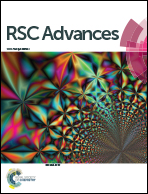A simple highly sensitive and selective TURN-ON fluorescent chemosensor for the detection of cadmium ions in physiological conditions†
Abstract
A very simple fluorophore was synthesized and applied as a chemosensor for Cd2+ ion detection. Structural characterization was done using 1H and 13C NMR and ESI-mass spectrometry techniques. All the fluorimetric titrations were carried out using spectrofluorimetry. The fluorophore has shown a very good LOD of 1 fM towards Cd2+ ions. The linear range of detection is 5 fM to 1 mM. Moreover, it has successfully discriminated Zn2+ ions and all interfering metal ions at physiological pH (7.0). The quantum yield of the fluorophore increased from 0.4 to 0.78 after the binding of Cd2+ ions. The formation of a 1 : 1 complex is confirmed by a Job’s plot, 1H NMR and ESI-mass spectrometry. All the spectral evidences have strongly shown the formation of a 1 : 1 binding mode. The binding constant is also calculated for the probe–Cd2+ ions in lower (femto) concentrations such as 2.2 × 103 M−1. The chemosensor has also exhibited very good results in HeLa cell imaging under physiological pH. So the chemosensor that has been developed can be recommended for practical biological applications especially in oncology.


 Please wait while we load your content...
Please wait while we load your content...